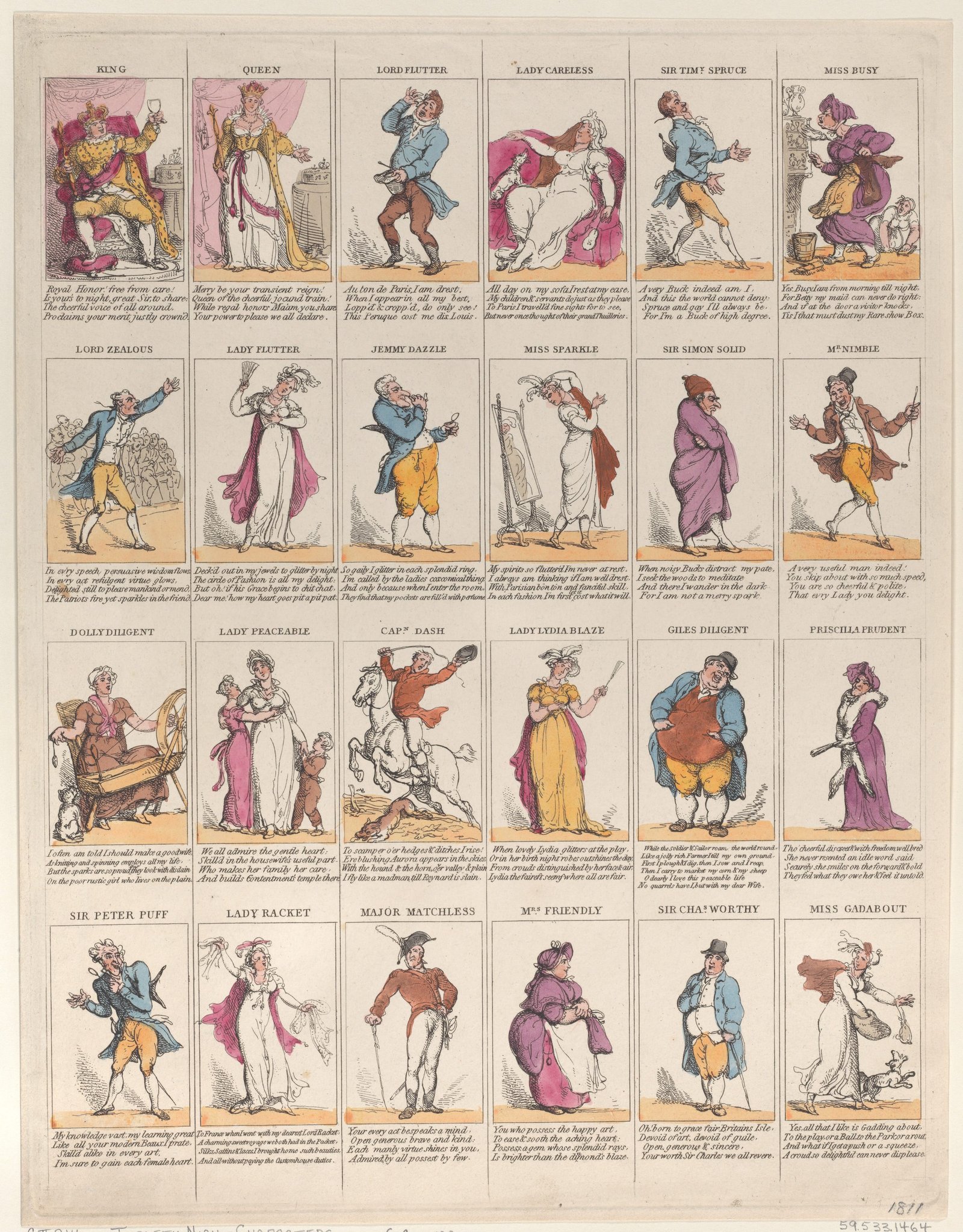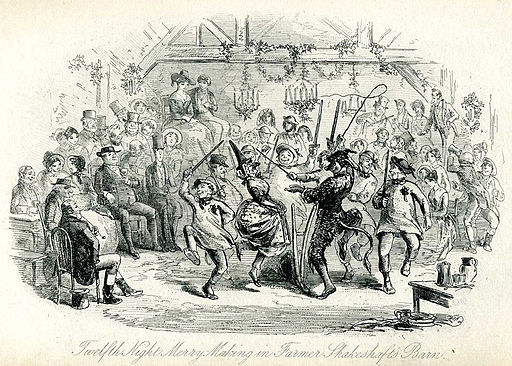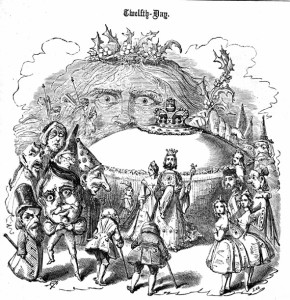Regency Christmas Traditions: Twelfth Night Revelries

Who can resist a holiday party?
During the Regency era, the party of the year would generally be held on Twelfth Night.
Twelfth Night Revels
Epiphany or Twelfth Night (Jan 5 or 6 depending on who was counting) was the exciting climax of the Christmastide season and a time for putting away social norms. It was a feast day to mark the coming of the Magi bearing gifts to the Christ child, and as such was the traditional day to exchange gifts. Decorations were to be taken down and burned by midnight on this day or the household would face bad luck for the rest of the year. Some believed that for every branch that remained a goblin would appear.
Twelfth Night Characters
Revels, masks and balls were the order of the day and night. Typically each guest would randomly select a character to play by drawing a slip of paper from a hat or bag. Some hostesses would send characters around to her guests so that they could come already dressed as their character. Others might provide dress up items for their guests to don after characters had been chosen. Guests had to remain in character for the entire evening. If a guest broke out of character during the night they would have to pay a forfeit later.
Besides the King and Queen, a variety of characters, were often pulled from popular literature and plays. Common characters were Sir Gregory Goose, Sir Tumbelly Clumsy, Miss Fanny Fanciful and Mrs. Candour. Sets of pre-made characters could be purchased from stationers, or a family might copy them from books on games and merry-making.
Rachel Revel offered an extensive set of characters in her book as well as instructions that as each character is drawn the conductor of the game arrange them in order of their number and when all the guests have characters, they may each read lines to introduce their character in turn.
For example:

1. King: Fate decrees me your King: grave and gay,wise and fools, Must consent, for this night, to submit to my rules.
2. Queen: I’m your Queen: good my liege, your confessor, may shrive you; But for me, I’m resolved, if I can’t lead I’ll drive you.
3. Lord Spendthrift: Blood, for money, Lord Spendthrift is ready to barter, If some rich maid will purchase a Knight of the garter.
4. Molly Mumper: Molly Mumper wants a husband: Baron, or Duke, she cares not which; If you’ll marry a beggar’s heiress, she’ll promise to make you rich.
5. Lucy Leerwell: “Tis so humdrum to live single, Lucy Leerwell would prefer, On some facetious youth, her hand and fortune to confer.
6. Joe Giber: Take Joe Giber, the king’s jester, he’s the fellow for your yoke, Tho’ marriage, it must be confess’d, by most wits is counted no joke.
7- Miss All-agog: Miss All-agog’s a candid girl, who hates monastic vows, And she will never take the veil if she can get a spouse.
8. Sam Sadboy: Sam Sadboy’s neither monk nor friar; he sees into your views:Marry him, you may cast off your veil, and the rest of your deeds when you choose.
9. Miss Romance: Miss Romance to accept for her partner proposes, One who’ll print in his press ev’ry work she composes…

Servants were often included in the revelries. This could become particularly interesting when one became the king or queen for the evening.
Mince Meat Pie
Though many dishes graced the tables for Twelfth Night revelry, two particular dishes were known for their connection to Twelfth Night. Most considered mince meat pies, also known as Christmas or Twelfth Night pies staples for a Christmas feast. Recipes varied by region, but usually included beef, poultry and other meats, suet, sugar, raisins or currants, spices, orange and lemon peel, eggs, apples and brandy.
Leftovers from the Christmas feast would be used to make pies for the twelve days until Epiphany. Eating minced pie every day of the twelve days of Christmas was said to bring twelve months of happiness in the new year. To strengthen the charm, the pies must be baked by the dozen and offered by friends.
Twelfth Night Cake

A special Twelfth Cake, would be the centerpiece of the party. The cakes were elaborate creations with sugar frosting, gilded paper trimmings, and sometimes delicate plaster of Paris or sugar paste figures.
In towns, confectioners would display these cakes in their shop windows, illuminated by small lamps so the displays could be admired during winter evenings. Recipes for Twelfth Cake do not appear in print until 1803, although either of these recipes might have been used prior to that to make it.
To Make a Rich Cake
Take four pounds of flour dried and sifted, seven pounds of currants washed and rubbed, six pounds of the best fresh butter, two pounds of Jordan almonds blanched, and beaten with orange flower water and sack till fine; then take four pounds of eggs, put half the whites away, three pounds of double-refined sugar beaten and sifted, a quarter of an ounce of mace, the same of cloves and cinnamon, three large nutmegs, all beaten fine, a little ginger, half a pint of sack, half a pint of right French brandy, sweet-meats to your liking, they must be orange, lemon, and citron; work your butter to a cream with your hands before any of your ingredients are in; then put in your sugar, and mix all well together; let your eggs be well beat and strained through a sieve, work in your almonds first, then put in your eggs, beat them together till they look white and thick; then put in your sack, brandy and spices, shake your flour in be degrees, and when your oven is ready, put in your currants and sweet-meats as you put it in your hoop: it will take four hours baking in a quick oven: you must keep it beating with your hand all the while you are mixing of it, and when your currants are well washed and cleaned, let them be kept before the fire, so that they may go warm into your cake. This quantity will bake best in two hoops.
To make icing for a Bride Cake.
Almond Iceing for the Bride Cake. Take the whites of six eggs, a pound and half of double refined sugar; beat a pound of jordan almonds, blanch them, and pound fine in a Iittle rose water; mix all together, and whisk it well for an hour or two; then lay over your cake, and put it in an oven.
~Every woman her own housekeeper John Perkins 1790
The end of Twelfth Night Revels
Although Twelfth Night revelry could be peaceable and even family-friendly, it often became quite riotous as rowdy games and large quantities of highly alcoholic punch were the order of the evening. In the 1870′s, Queen Victoria outlawed the celebration of Twelfth Night in fear the celebrations had become out of control.
References
A Regency Christmas By Kieran Hazzard ©2013 2nd Bn. 95th Rifles
Glasse, Hannah. The Art of Cookery Made Plain and Easy. (1784)
London Every woman her own housekeeper John Perkins 1790
Christmas in the Regency Jo Beverley
Christmas Traditions in Regency England. Regan Walker
Christmas Frivolity. Joanna Waugh. 2008.
‘Winter Evening Pastimes or The Merry Maker’s Companion’ Rachel Revel, 1825
Jane Austen and Christmas: Celebrating Twelfth Night
Jane Austen and Christmas: Parlour Games for the Season and Twelfth Night
If you enjoyed this post you might also enjoy:

‘Tis been fascinating to read about the regency Christmas traditions over this last month. Thank you to all writers who contributed. Some of the traditions were still current in our house when I was growing up in Scotland and England. My Grandmother, who lived with us would make the Christmas puddings, including the sixpences. she always referred to Christmas ‘boxes’, not presents. Mum would make the rich fruit Christmas cake some weeks earlier, leaving it to soak in brandy before finally covering it with marzipan and royal icing. In those days we children didn’t like fruit cake so we only ate the icing. After lunch all the adults would have a snooze so we entertained ourselves with our new toys until they woke up and then the board games or cards came out. On New Year’ Eve my father would go first footing with his lump of coal. Being reasonably tall and dark haired he was always welcome but somewhat inebriated by the time he returned. Unlike today, we never put up the decorations until Christmas Eve and took them down on January 6th after 12 days.
Christmas is very different now, not least because I live in New Zealand and it is summertime.
Fascinating yet again. I have read many books containing Twelfth Night Parties, but have never known much of the traditions, being that they are not commonly celebrated in the US. I have had friends who celebrate The Three Kings, so that is much more familiar to me.
For me as a modern Anglican (Reformed Episcopal), Twelfth Night celebrations are both a kiss goodbye to Christmastide and a welcome of Epiphanytide. Our party is always the 5th of January at sunset when we “burn the greens.” Our priest reminisces about the huge bonfires his church in Colorado used to have when he was a boy with hundreds of Christmas trees such that the fire department watched the smoldering remains all night, putting out hot spots.
Since we’re constantly under fire danger here in the mountains of Southern California, we burn a few handfuls of greens in a small metal-lined fire pit as the sun sets, praying together the first Evensong of the Epiphany. (For Anglicans, as with the Jewish faith, celebrations of holy days begin at sunset of the previous day and last through the next sunset.) Then we go into the house and enjoy Christmas trifle and sherry–yum!! 🙂
So I am very much looking forward to celebrating Twelfth Night/Eve of Epiphany tomorrow night! 🙂
~Susanne 🙂
Six lbs of butter and a pound and a half of
sugar…wow!
Thank you for this series, which I have really
enjoyed reading. Happy New Year 2016.
This has been a wonderful series of focused information.
Thank you.
I don’t own equipment (pots, pans, bowls) large enough to handle the large cakes. But it is interesting how elaborate some of these celebrations are…how much money went into the staging of such!
Our family never had any celebrations outside of Christmas Day. When I married a man of Roman Catholic faith we began to attend midnight masses but I gave that up a few years back as I need my sleep.
Sian – your family sounds interesting in their traditions. And I will never see New Zealand but the films set there and the photos of it show it to be a gorgeous land!
It was interesting to read about some of the celebrations in the various P&P books.
Wonderful series, very enjoyable (and educational).
And thank you for the freebies!